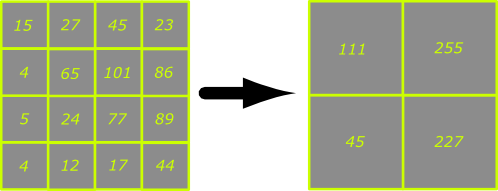Glossary of Light Microscopy Terms
Binning
Binning is a process used to increase the sensitivity of a CCD camera by combining the charge from adjacent pixels to boost the signal-to-noise ratio in the image. If we imagine a hypothetical camera (see below) with a chip consisting of 4x4 pixels and we apply a binning factor of 2x then 2x2 arrays of adjacent pixels will be combined together to form an array of 'super pixels' that are four times the area of the originals and contain the combined charges of the adjacent pixels. This improves the signal-to-noise ratio because CCD camera readout noise often obscures low signals. If the readout noise of the hypothetical camera below is 25 grey levels then most of the signals in the image on the left will be indistinguishable from noise. By combining the charges from adjacent pixels the readout noise threshold is easily exceeded in most of the pixels in the image on the right.
Image acquisition is also faster for binned images because the readout time is shorter and the exposure time is usually shorter too. The drawback of using binning is that the resolution is lower because the specimen is now being sampled by fewer pixels. For example, a specimen imaged with the hypothetical camera above in 2x binning mode would be sampled by four large pixels instead of 16 small ones. The images below broadly illustrate the effect of increasing binning factors on resolution. At high binning factors pronounced pixelation is seen in the images when all are magnified to the same dimensions.
What does binning mean? (Andor Technologies)
Numerical Aperture (NA)
The numerical aperture is a dimensionless value that characterises the resolution of a lens. It is defined by the following equation:
NA = n sinθ
Where n is the refractive index of the immersion medium and θ is the half-angle of acceptance of the lens.
The higher the NA the higher the resolution of the lens. The NA cannot exceed the refractive index of the immersion medium, so lenses for use in standard immersion oils (n ≈ 1.51) tend to have a maximum NA of 1.4 to 1.45
Links:
Numerical Aperture (Wikipedia)
Working Distance (WD)
The working distance is the distance from the front of the lens to the nearest surface of the coverslip when the specimen is in sharp focus. For objective lenses designed for use without a coverslip the surface of the culture vessel or specimen in used.
Links:

